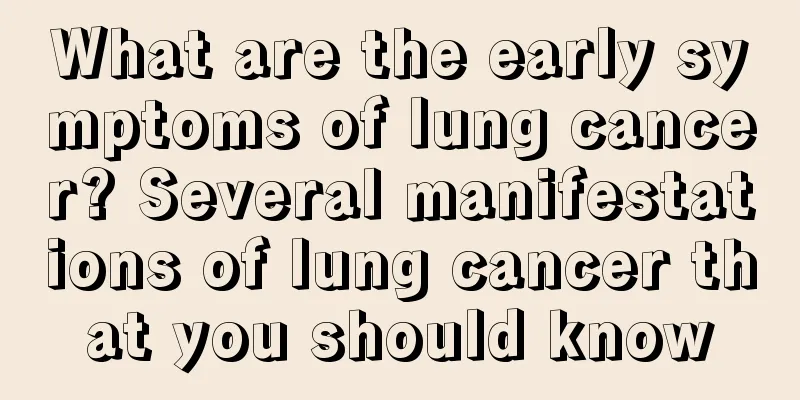What are the early symptoms of lung cancer? Several manifestations of lung cancer that you should know

|
Lung cancer is a disease with a high incidence rate and a relatively low cure rate in my country. A comprehensive understanding of the early symptoms of lung cancer is more conducive to early detection of the disease, early diagnosis and early treatment, so that patients can take the lead in treatment. Its symptoms include cough, blood in sputum, low fever, chest pain, and shortness of breath. In recent years, with the improvement of medical standards, many diseases can be detected in the early stages of the disease, so that patients can receive effective treatment in the initial stage of the disease to curb the continued development of the disease. As a country with a high incidence of lung cancer, my country has tens of thousands of patients diagnosed with lung cancer every year. In order to detect and diagnose lung cancer in its early stages, we must have a clear understanding of the early symptoms of lung cancer. So what are the early symptoms of lung cancer? There is nothing special about the early symptoms of lung cancer. They are just the same symptoms as those of general respiratory diseases: cough, blood in sputum, low fever, chest pain, shortness of breath, etc. Some patients may only show one of these symptoms, while others may have several symptoms. Therefore, it is easy to be ignored. Therefore, it is more helpful for us to have a clearer and more comprehensive understanding of the common symptoms of early lung cancer, which is more conducive to our self-screening. 1. Cough. Lung cancer grows on bronchial lung tissue, and usually causes an irritating cough due to respiratory irritation symptoms. 2. Low-grade fever. When a tumor blocks the bronchus, there is often an obstructive lung lobe. The degree of the disease varies. In mild cases, there is only a low-grade fever, while in severe cases, there is a high-grade fever. The disease may improve temporarily after medication, but it will relapse soon. 3. Chest pain. In the early stages of lung cancer, chest pain is mild and is mainly manifested as dull pain, dull pain, and the location is uncertain, and the relationship with breathing is also uncertain. If the pain persists, it means that the cancer may have affected the pleura. 4. Blood in sputum. When tumor inflammation causes necrosis and capillary damage, there will be a small amount of bleeding, which is often mixed with sputum and appears intermittently or intermittently. Many lung cancer patients seek medical treatment because of blood in sputum. The above are some early symptoms of lung cancer. If you have similar symptoms, you must go to a professional hospital for a final diagnosis as soon as possible. Before the diagnosis, don't have any mental burden, relax, keep a regular schedule, exercise properly, and maintain healthy sleep and diet. After the diagnosis, cooperate with professional doctors for treatment, and you will definitely recover your health as soon as possible. |
Recommend
The cause of vomiting and fever in polycystic kidney disease turns out to be this
Symptoms of vomiting and fever in patients with p...
What tests should be done for teratoma
Teratoma is an uncommon disease, and it often occ...
What is the reason for pain in the left elbow joint
Pain in limb joints is common in our daily lives,...
How to demagnetize garnet
We all know that the garnet we just bought needs ...
My ear piercing has been bleeding for a month
Ear piercing is a very common thing in modern tim...
Several common examination methods for nasopharyngeal carcinoma
The clinical examination of nasopharyngeal carcin...
Is it scientific not to eat after noon? Why?
Not eating after noon is a practice that originat...
Can chronic hepatitis C be cured?
In fact, hepatitis C disease is divided into chro...
What are the most common symptoms of infection in newborns?
Newborn babies are called neonates. As we all kno...
Why do thighs get fat
The thigh is an important part of the human body....
Does seahorse soup have the efficacy and function of treating enuresis?
There is a common creature in the deep sea. It is...
Is it serious if the urine test shows more than 200 bacteria?
Modern people's lifestyles are generally irre...
Pure Chinese medicine treatment for prostate cancer
Traditional Chinese medicine has a long history o...
Glucose hydrochloride takes effect
As we age, our physical health will decline, espe...
Will there be any side effects of iodine absorption rate in treating hyperthyroidism
Iodine absorption rate is more suitable for the t...









